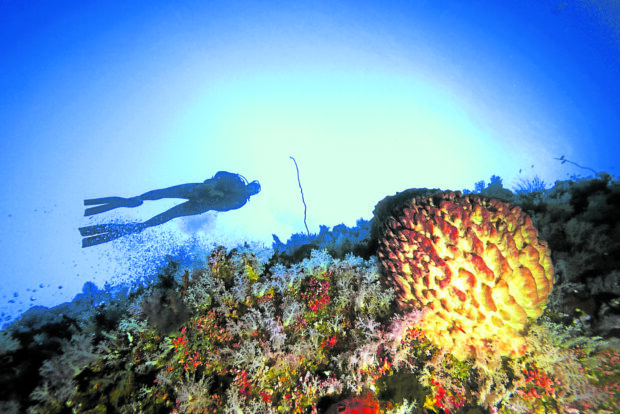Marine bacteria in Tubbataha show anti-cancer properties

CURE FROM THE DEEP | One of the features of the Tubbataha Reefs Natural Park shown in this 2013 photo holds promise as a source of microorganisms that can be used to develop antibiotics and anticancer drugs. (File photo by YVETTE LEE)
MANILA, Philippines — For the last five years, scientists from the University of San Agustin (USA) in Iloilo province have been combing the country’s oceans for microorganisms that can cure intractable diseases.
This year, they finally discovered a new species of marine bacteria in the sediments of Tubbataha Reefs in the Sulu Sea that could be developed into antibiotic, anti-cancer drug compounds.
Their findings — published in the American Society for Microbiology Journal — were the first to explore the pharmaceutical potential of microorganisms in Tubbataha, declared by the United Nations Educational, Scientific and Cultural Organization as a World Heritage Site in 1993.
A series of tests on the species named Streptomyces tubbatahanensis, after the famed reefs where it was discovered, showed its ability to kill wound-infecting bacteria and even inhibit the growth of colon and ovarian cancer cell lines.
Chuckcris Tenebro, the study’s lead author and a project technical specialist IV at the Center for Chemical Biology and Biotechnology (C2B2), USA, said the discovery of erythromycin — an antibiotic used to prevent or treat infections — from a soil sample in Iloilo in the 1950s inspired them to look for new antibiotics in unexplored marine sediments in different collection sites across the Philippines.
Article continues after this advertisementWith their discovery, they hope to show that “we have untapped resources that could be the next candidates for drug development,” Tenebro said, adding: “We just need the expertise, facilities, and government support for the discovery of more compounds that can benefit mankind and society.”
Article continues after this advertisementThe team started collecting marine sediments from Tubbataha Reefs in 2018 under the supervision of Dr. Doralyn Dalisay, a Balik Scientist under the Department of Science and Technology (DOST), with funding from the National Research Council of the Philippines.
At the time, they hoped to build on existing research about the Streptomyces genus, seen as a very important bacterial family that was the source of many of the world’s antibiotics. The newly discovered S. tubbatahanensis is part of this bacterial family.
Found in the bacteria is a compound called Chlocarbazomycin A, which is believed to have antibiotic and anticancer properties.
However, much of the available literature “did not find or provide a pathway” on how Streptomyces produced the compound—a gap their research hoped to fill, Tenebro said.
The team is doing further studies on how best to harness the bacteria’s potential.
Long way to go
“It would take more years and a lot of testing for us to validate the safety and efficacy of the compounds,” he said. “But as they say, we still have a long way to go—but we have also gone a long way.”
The race to develop this “bacteria sa buhangin (bacteria in the sand),” according to Science Secretary Renato Solidum Jr., was also part of broader efforts to boost the country’s “blue economy.”
He said they were hoping to fund and lead more studies on how to leverage the country’s rich ocean biodiversity into more jobs, stronger local economies, or, in this case, drugs that could help Filipinos.
This was especially important in the Visayas region, where communities survive mainly on fisheries and aquaculture, marine tourism and marine transport, said DOST Western Visayas Director Rowen Gelonga.
Tenebro acknowledged that while their study opened up the possibilities of harnessing oceans for drugs, this must also be done sustainably.
To do this, they worked with the Tubbataha Protected Area Management Board and the Palawan Council for Sustainable Development to ensure they would minimize harm to the marine ecosystem.
On Jan. 17, 2013, while sailing to Indonesia following a port call on Subic Bay, the minesweeper ship USS Guardian ran aground on the south atoll of the Tubbataha Reefs and damaged 2,345 square meters of coral.
The Tubbataha Management Office demanded compensation of around $1.4 million (about P60 million) for the damage. Under Republic Act No. 10067 or the Tubbataha Reefs Natural Park Act of 2009, a fine of about $600 or P24,000 per square meter of damaged reef was mandatory.
On Oct. 25 last year, the Palawan provincial government finally received P58,375,080 for the “rehabilitation of Tubbataha.” According to government officials, the funds would be used to renovate the living quarters of Tubbataha park rangers.